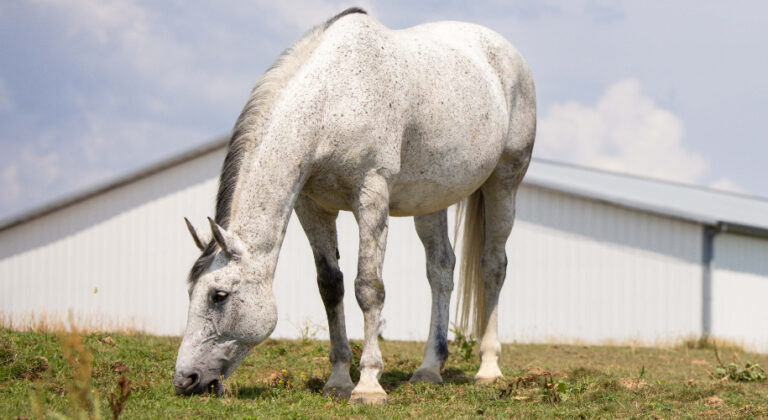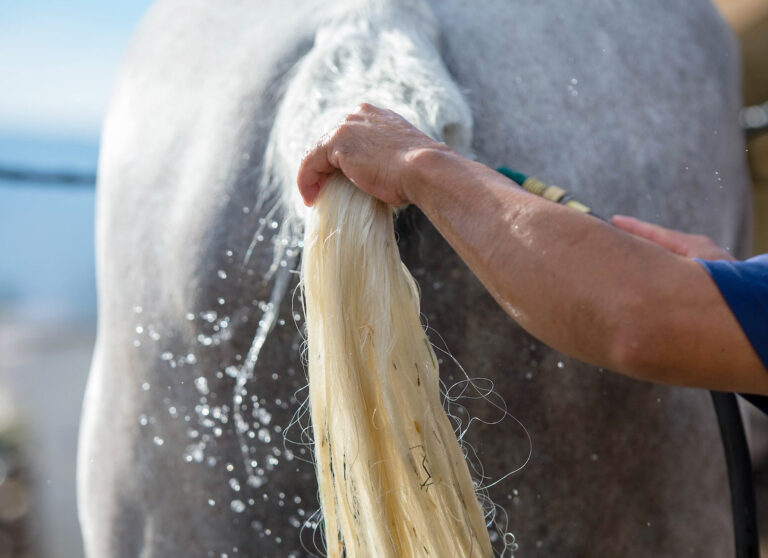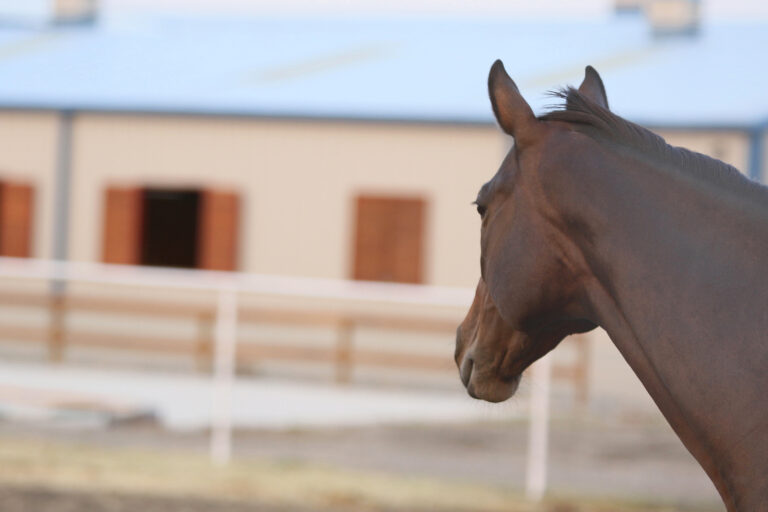

Old age ain’t no place for sissies,” the actress Bette Davis reputedly said, and it’s true for every species. In horses, advancing age can usher in a host of troubles from arthritis to respiratory problems. And thanks to lighter workloads, better nutrition and care and a bump in status to valued companion, more horses than ever make it to the golden years today.
If your horse is in that group, how can you keep him happy and healthy? Here you’ll find practical tips from three experts—Amanda Adams, PhD, assistant research professor at the University of Kentucky’s Gluck Equine Research Center; Dee Doolittle, founder and executive director of Mitchell Farm, an equine retirement farm in Salem, Connecticut; and Brian Nielsen, PhD, professor of animal science at Michigan State University.
The late teens—ages 18 to 20—are generally said to mark the start of old age for a horse. But age, as the saying goes, is just a number. “A horse can be spry at 30 or worn out at 17. Go by what you see, not by years,” says Dr. Nielsen, who teaches equine management and exercise physiology. If your horse is physically active and healthy, you may not need to change much. If he shows signs of physical deterioration or health problems—weight loss, arthritis, dental issues, colic, respiratory difficulties—you need to adjust his program. (To learn about equine Cushing’s disease, a common age-related disorder in horses, see the box below.)
Dr. Adams agrees. “It’s important to consider horses as individuals as they age,” she says. She is among several researchers who are studying the effects of nutrition on age-related health problems. Genetics, management and environment all affect the aging process, she notes, so care and feeding should be targeted to meet the horse’s specific requirements.
Base Feed on Need
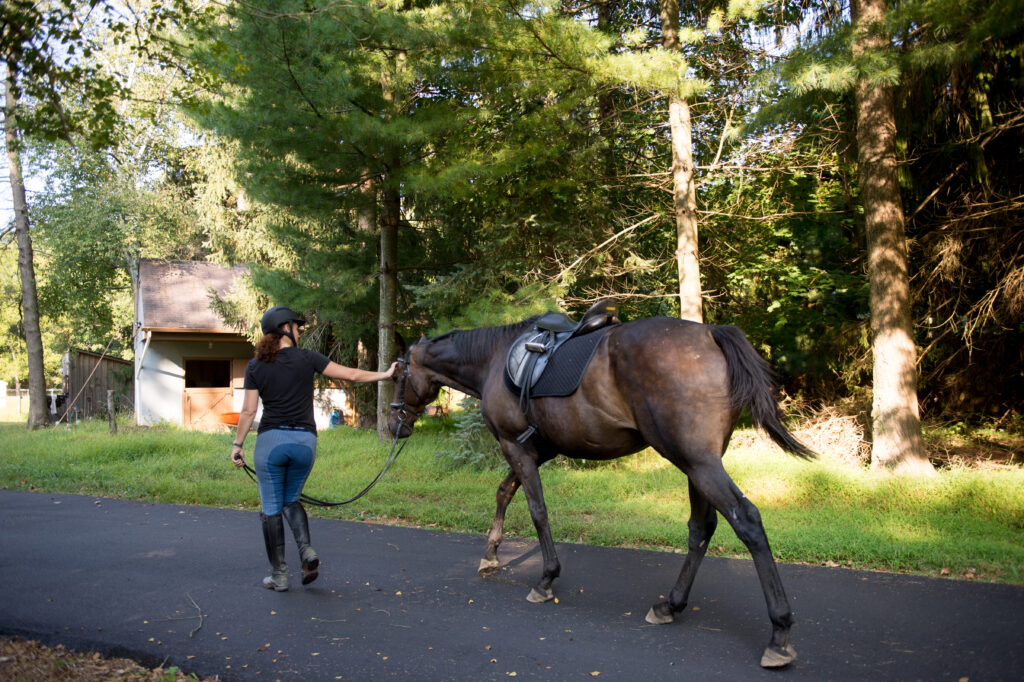
If your horse is a senior, does he need senior feed? Not necessarily, says Dr. Nielsen. You may have read that old horses have particular trouble absorbing nutrients from feed and forage, but researchers at Michigan State found that’s not always so. Their study compared digestion of macronutrients (carbohydrates, protein and fats) in two groups of PMU mares, one group aged 5 to 12 and the other aged 19 to 28. “The PMU mares were ideal because they’d had identical management through their lives,” Dr. Nielsen says. There was no significant difference between the groups.
But while age alone doesn’t change dietary needs, conditions that may come with age can. Parasites can leave the intestinal lining scarred, for example, affecting nutrient absorption. And physical problems from tooth wear to endocrine disorders may dictate changes in a horse’s diet. Here’s how to stay on top of the situation:
• Keep an eye on the horse’s condition using an objective yardstick like the Henneke Body Condition Scoring System. “There’s no need to change the diet unless you see a change in the horse,” Dr. Nielsen says. “And if you see a change, such as a drop in weight, look for the cause. Don’t just assume it’s because he’s old. He may be losing weight because he’s not getting enough hay. Or his teeth may need attention, making it hard for him to chew hay.” (More on those dental problems soon.)
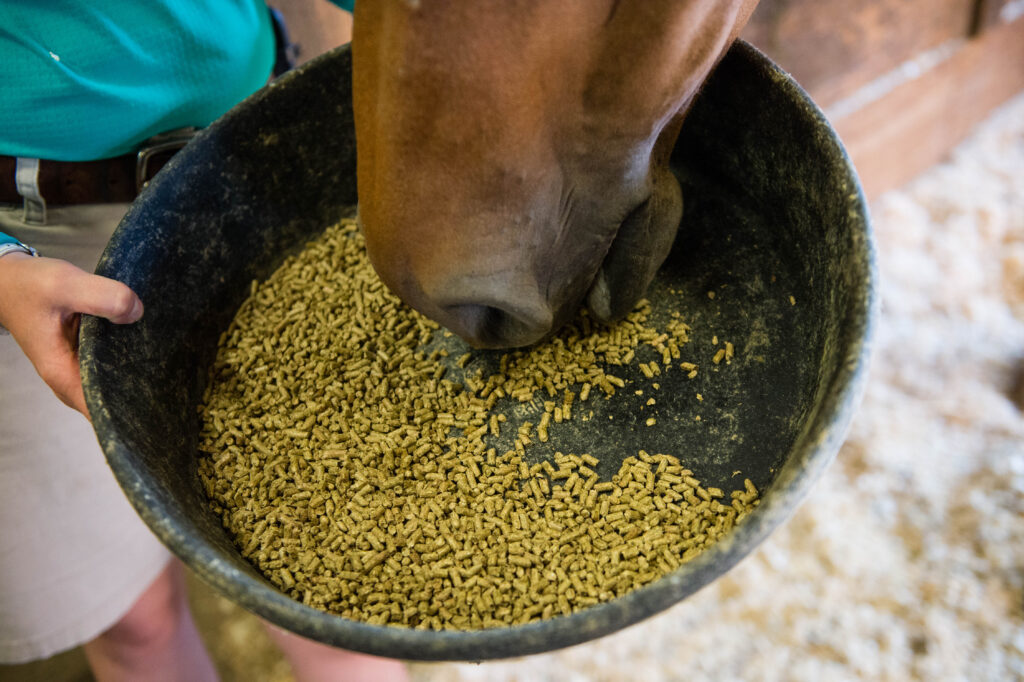
• Make forage—green grass and good hay—most of an older horse’s diet. It’s a must for intestinal function and it provides enough calories and protein for horses doing little or no work. “It’s also the healthiest and simplest way to put weight on a horse that’s too thin,” Dr. Nielsen says.
• Use concentrates and supplements to fill vitamin and mineral gaps in forage. Commercial ration balancers are formulated to do this. Senior feeds and other nutritionally balanced commercial concentrates can also fill the gaps when they’re fed at amounts recommended on the label. Most of the retirees at Mitchell Farm, who range in age from 17 to 35, get senior feed that includes some roughage and is easy to chew.
• Give horses with special needs the dining arrangements they need. “Choke is a constant risk for older horses with dental problems,” Dee says. She suggests feeding small but frequent meals and either soaking feed or spreading it out in a large pan feeder to reduce the danger of choke. For a horse with heaves, wet hay to reduce dust and put hay and feed pans on the ground. Eating with his head lowered will help the horse clear his airways.
“An older horse may take longer to eat, especially if he has dental problems,” Dee adds. “Give him as much time and feed him as many times a day as necessary.”
Keep Him Moving
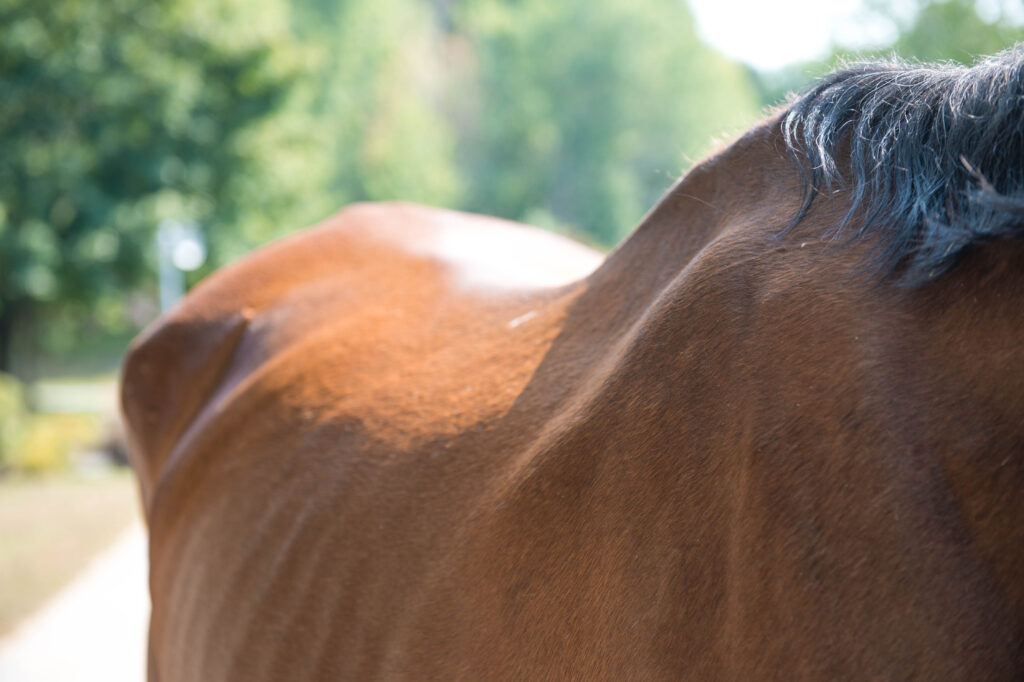
Many older horses are inactive. “They may no longer be competitive, so they aren’t ridden as much, or they have physical problems such as arthritis that limit what they can do,” says Dr. Nielsen. “But regular exercise is beneficial as long as it’s within the horse’s abilities. It keeps him sounder and happier.”
That said, you don’t want to overtax him. Watch for:
• Signs of exercise intolerance. Even if he’s active and fit, a horse in his 20s may tire more quickly, overheat more easily and lose more fluid in sweat doing the same amount of work he’s done in the past. Changes in his cardiovascular function and ability to regulate body temperature and fluid balance may mean you’ll need to do less intense work, skip your ride on hot days and make other adjustments. If he’s been out of work for a while, Dr. Nielsen says, “Start slow and build up gradually. It’s hard for an older horse to regain fitness.”
• Signs of arthritis. If you see stiffness or soreness, especially at the start of work, ask the veterinarian to evaluate the horse. Chronic arthritis worsens over time, but most horses with this condition benefit from light to moderate exercise, which keeps joints moving. You can help by giving the horse long, slow warm-ups and by avoiding hard, rough or sloppy footing.
• Changes in the horse’s topline, which can affect saddle fit. The muscles, tendons and ligaments that support the spine tend to lose tone with age, so the back can begin to sag behind the withers. Regular exercise can delay the changes, but you may still need to have your saddle refitted.
Life is Better Outside
“Old and young horses are better off out of the barn,” Dr. Nielsen says. “Outside, they’re not breathing dust and other contaminants that build up in enclosed stables. That’s especially important for horses with respiratory problems, like heaves, which are common in seniors. Older horses also stay sounder if they can move around freely outside. And there’s a social aspect—they’re happier outside in contact with other horses.”
If your senior horse can live outdoors, great—but keep in mind:
• Horses (old or young) that spend all or most of their time outside need access to a run-in shed or similar shelter. “They should always have the option to get out of the weather,” says Dr. Nielsen.
• Older horses tend to hold low rank in a herd and may be bullied. It’s important to watch and separate them if this is happening. “In a group, older horses can be pushed aside at feeding time,” says Dee. “We have mostly geriatric horses, and we bring them in for at least enough time to let them all eat in peace.”
Expect Tooth Trouble
Watch the horse eat. You may see grain dribbling from his mouth. Wads of half-chewed hay may collect in his cheeks or drop to the ground. But the tipoff to a dental problem isn’t always obvious, Dee says. “It may be something as subtle as how he holds his head when he chews.”
After a lifetime of grinding hay, excessive tooth wear and other dental problems are almost inevitable. Uneven wear, sharp points that irritate the mouth, molars ground down to stubs, cracked or missing teeth—all cause discomfort and make it hard for old horses to get the nutrition they need. A qualified veterinary dentist can address problems. An annual visit may not be enough. “We have the dentist out to check the horses every six to eight months and more often to address specific problems,” Dee says.
Several horses at Mitchell can’t eat hay at all due to dental problems, she adds. They get hay replacements—“different replacements depending on what the horse needs.” Options include hay-stretcher pellets, hay cubes and chopped forage. These can also help put pounds on a thin horse.
Don’t Skip Shots


“Old horses are susceptible to infectious disease despite the fact they may have pre-exisiting immunity due to either vaccination or infection,” says Dr. Adams. In fact, research shows that the ability to mount an immune response lessens with age, a development called immunosenescence. “Old horses have reduced immune responses to vaccination,” she says. “We think that old horses with equine Cushing’s disease may respond even less to vaccinations, but more work needs to be done to confirm this.”
Despite a weaker response, she says, regular vaccinations can keep immunity at protective levels in seniors. She recommends following vaccination guidelines from the American Association of Equine Practitioners. “If the horse is still competing, traveling or being co-mingled with other horses, talk with your vet about twice-a-year vaccination for risk-based vaccines like equine influenza and West Nile virus,” she says.
Keep Up Routine Care

An old horse may be working less, but basic care is as important as ever—maybe more so.
• Schedule the farrier. “Regular hoof trimming is important because many senior horses have arthritis, and letting the feet get long puts stress on joints,” Dee says. The retirees at Mitchell Farm have their feet trimmed every five weeks or so.
• Screen for parasites. In her research, Dr. Adams has also found that older horses often have higher fecal strongyle-egg counts than middle-aged horses, although deworming is equally effective in both groups. This doesn’t mean that senior horses need more frequent deworming—just that fecal egg counts may need to be checked more often to be sure that parasites are under control. Your horse’s veterinarian can help you devise a deworming program that takes his age into account.
• Check him daily. While regular grooming is important, most retirees don’t need a full grooming every day. “Many retired horses don’t like to be groomed—they associate grooming with work,” Dee says. “But a daily hands-on check is essential. Look for scratches, bumps and any other signs of injury or problems.”
The daily check is especially important for horses with equine Cushing’s disease, she adds, because they don’t often heal well.
Help Him In Heat And Cold


Because a senior horse may not be able to regulate his body temperature as well as he could in his younger days, hot summer days and cold winter weather can be hard on him. Here are some ways to help.
• Give him shade in summer, keep him in during the hottest part of the day and run a fan in his stable. Avoid work that could overheat him.
• Watch his weight in winter. If he’s burning more calories to keep warm, he’ll start to shed pounds. You may need to adjust his diet—add some senior feed, say—to increase calories. “Not all senior horses lose weight in winter,” Dr. Nielsen says. “But for those that do, it helps to start the season with a few extra pounds.”
•Blanket—or not. Go by body condition and coat, Dr. Nielsen suggests. “If the horse or the coat is thin, a blanket can help. If he’s at the right weight and has a full winter coat, he may not need it.”
• Watch his water bucket. Horses often drink less in cold weather, and that puts them at risk for impaction colic. A senior horse already faces high colic risks, so keep an eye on his water intake. Adding warm water to his bucket and supplemental salt to his diet may encourage him to drink more. Soaking his feed in warm water will also get more fluid into him.
Pay Attention
Arthritis, cancers, colic, Cushing’s disease, glaucoma, heaves, laminitis—health problems multiply as a horse ages. Some arrive with drama while others creep up insidiously. How can you spot them?
“Know the horse’s routines and habits, his idiosyncrasies, and key in on any change. Be alert to changes in behavior,” Dee advises. “When you really know the horse, you can tell at a glance when something’s not right.”
A very old horse may have hearing loss, cataracts and other sensory problems that make him seem a bit dim, she adds. If you have a barnful of horses to feed and go down the row dumping grain quickly, he may miss the feed going into his bucket and not realize it’s there. Or he may eat some but then be distracted and forget it. You need to go back and check.
Paying attention to little things like this may be the most important part of caring for a senior horse, Dr. Nielsen agrees. “Take action as soon as you see a change in his body condition, soundness or attitude,” he says. “An older horse, especially one that’s not in regular work, can be overlooked. We owe it to these horses to do right by them.”
Equine Cushing’s: What You Need to Know
Equine Cushing’s disease (pituitary pars intermedia dysfunction, or PPID) affects roughly 15 to 33 percent of senior horses. The disease affects the pituitary gland, a master gland that orchestrates the production of the hormones that regulate body functions. And like equine metabolic syndrome (which often appears in younger horses), it involves insulin resistance, a condition that makes it hard for the horse to process carbohydrates in feed and puts him at high risk for laminitis and other serious health problems.
“It’s critical that people understand how to properly diagnose PPID and insulin resistance in older horses, so they can get the horse on the correct treatment and nutritional regimens to prevent all the ugly things that come with these disorders,” Dr. Adams says.
Watch for early signs of PPID:
• The horse’s athletic performance declines. He may seem lethargic.
• He sheds out later than his herdmates in spring or keeps patches of long hair through the summer.
• Fat deposits build up along his crest, at his tailhead and above his eyes.
In time, other signs appear:
• He doesn’t shed much at all in spring and instead grows long, curly hair.
• He may drink more water and urinate more than usual.
• He may sweat more—or less.
• His body shape changes as his muscles waste away and he develops a potbelly.
• He’s more prone to infections.
Laminitis can occur at any point, even early in the disease, if insulin resistance develops. So it’s essential to contact your veterinarian as soon as you see signs.
Blood tests can identify PPID. One test measures resting adrenocorticotropin hormone, which is produced by the pituitary gland. Horses in the early stages of the disease can have normal results, though, so the vet may suggest a thyrotropin-releasing hormone-stimulation test. She can also check the horse’s insulin status with an oral-sugar or fasting-insulin test. That will help you gauge his risk for laminitis.
These test results will guide the treatment. Many horses with PPID do well on the drug pergolide. Those with insulin resistance also need to be on a diet that is low in sugar and starch—and they need to stay trim. “Obesity contributes to insulin resistance, although a horse doesn’t have to be overweight to develop the problem,” Dr. Nielsen says. Limiting sugar and starch may mean skipping grain, restricting grazing and soaking hay for an hour before feeding to leach out sugars. “Ensuring nutrition for these horses is a delicate balance,” Dee says. “If a horse can’t have enough senior feed to get necessary nutrients, we give a low-carb, high-protein supplement.”
Be sure to test and confirm that your horse actually is insulin-resistant before you make such major changes to his diet, Dr. Adams cautions. “I have seen old horses that have low body-condition scores because their owners were terrified of laminitis and switched them to low-carb diets without knowing how their insulin levels look,” she says. It’s mainly insulin resistance, not PPID alone, that increases the risk of laminitis.
This article originally appeared in the November 2015 issue of Practical Horseman.






